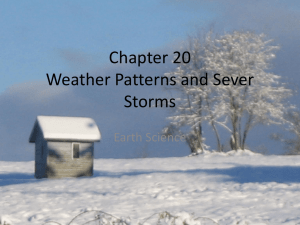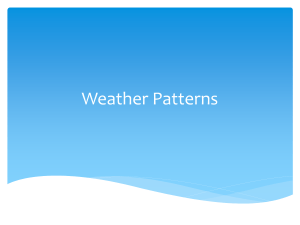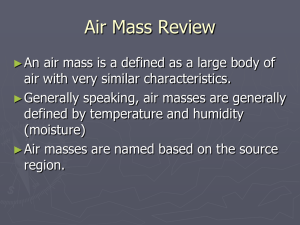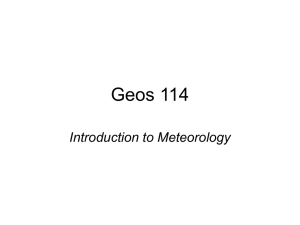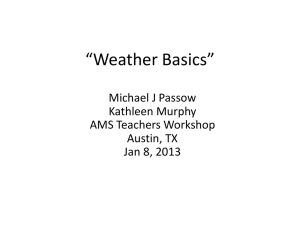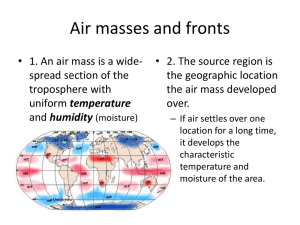Storm Stations - Helena High School
advertisement
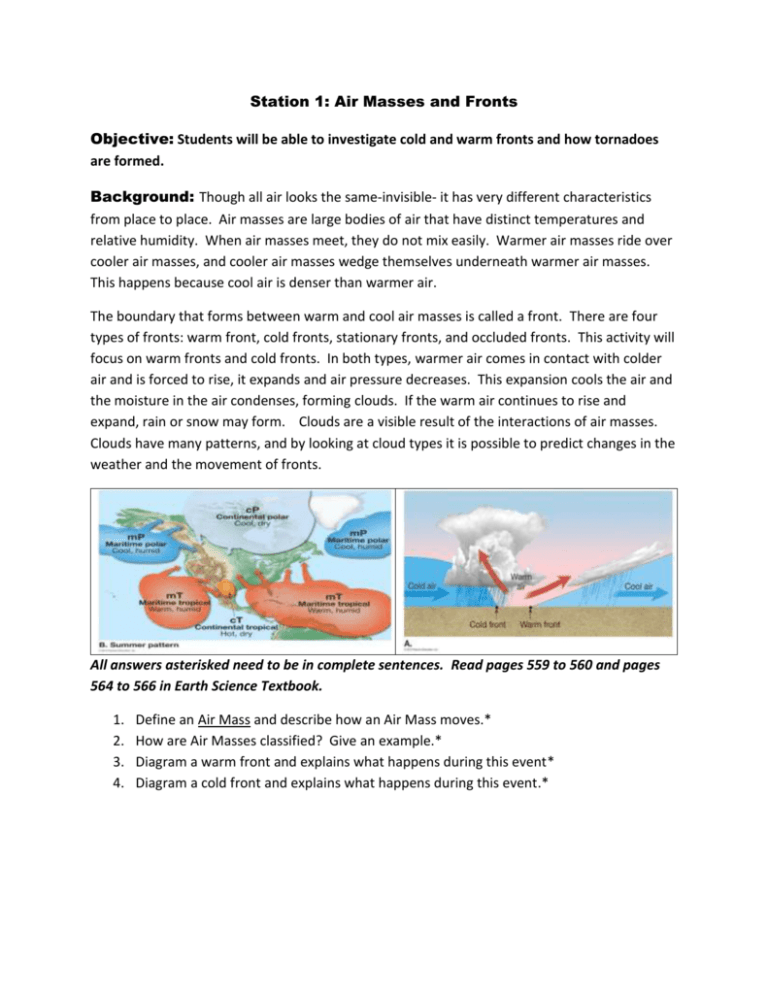
Station 1: Air Masses and Fronts Objective: Students will be able to investigate cold and warm fronts and how tornadoes are formed. Background: Though all air looks the same-invisible- it has very different characteristics from place to place. Air masses are large bodies of air that have distinct temperatures and relative humidity. When air masses meet, they do not mix easily. Warmer air masses ride over cooler air masses, and cooler air masses wedge themselves underneath warmer air masses. This happens because cool air is denser than warmer air. The boundary that forms between warm and cool air masses is called a front. There are four types of fronts: warm front, cold fronts, stationary fronts, and occluded fronts. This activity will focus on warm fronts and cold fronts. In both types, warmer air comes in contact with colder air and is forced to rise, it expands and air pressure decreases. This expansion cools the air and the moisture in the air condenses, forming clouds. If the warm air continues to rise and expand, rain or snow may form. Clouds are a visible result of the interactions of air masses. Clouds have many patterns, and by looking at cloud types it is possible to predict changes in the weather and the movement of fronts. All answers asterisked need to be in complete sentences. Read pages 559 to 560 and pages 564 to 566 in Earth Science Textbook. 1. 2. 3. 4. Define an Air Mass and describe how an Air Mass moves.* How are Air Masses classified? Give an example.* Diagram a warm front and explains what happens during this event* Diagram a cold front and explains what happens during this event.* Station 2: A Visual of Warm and Cold Front Objective: Students will be able to investigate cold and warm fronts and how tornadoes are formed. Materials: Plastic box, 400 ml beaker, small beaker, red and green (blue) pencil, red and green food coloring. Procedure: A. Cold Front - Obtain 20 ml of ice-cold water within small beaker. Put one to two drops of green food coloring in this ice-cold water. Then, holding the plastic container with both hands, fill with 500 ml of tap water. Position the plastic container as shown at station board. B. Get eye-level to the plastic container and place a white-backing behind container for observation purposes. Pour the ice-cold water into the plastic container as instructed by teacher. Observe as the cold (green) water moves toward the warmer water. The leading edge of this is similar to a cold front. Sketch (side view) what it looks like when the green water is about halfway through the warm water. Repeat the procedure to get another look at the cold front model. C. Warm front - Obtain 20 ml of hot water in small beaker. Put one to two drops of red or orange food coloring in hot water. Then, holding the plastic container with both hands, fill with 500 ml of tap water. Position the plastic container as shown on board. D. Get eye-level to the plastic container and place a white-backing behind container for observation purposes. Pour the hot water in the plastic container as instructed by teacher. Observe as the warm (red/orange) water moves toward the colder water. This is similar to a warm front. Sketch (side view) what it looks like when the red/orange water is about halfway through the colder water. Repeat the procedure. Analysis - all answers asterisked need to be in complete sentences. 1. 2. 3. 4. Why did the warm water behave as observed in the warm front procedure?* Why did the cold water behave as observed in the cold front procedure?* If a warm front hit Helena, what type of weather would you expect to occur?* Refer to the Weather Map B at this station, what type of weather would you expect in Southeast Montana and Wyoming?* 5. Refer to Weather Map A, describe the weather occurring in Utah?* Station 3 - Air Masses and Fronts continued. Part C. Tornado Tube. A. Read the following excerpt from Steve Spangler’s book, Weird and Wacky Things you can do with a Tornado Tube B. Then model a tornado using a Tornado Tube, and finally answer the analysis questions. Analysis - all answers asterisked need to be in complete sentences. 14. What is the relationship between air masses and tornadoes?* 15. Refer to page 573 and figure 18 (Honors refer to page 566 and figure 19.19), explain how a mesocyclone forms.* 16. Refer to page 573 (Honors refer to page 566), compare the tornado tube to a real vortex (mesocyclone) produced by a tornado.* 17. Refer back to page 574 (Honors refer to page 568 and Table 19.1), distinguish between an F4 tornado and an F2 tornado.* 18. Read about tornado safety on page 574 (Honors refer to page 567). How do meteorologist aid in prevention of harm done by tornados?


